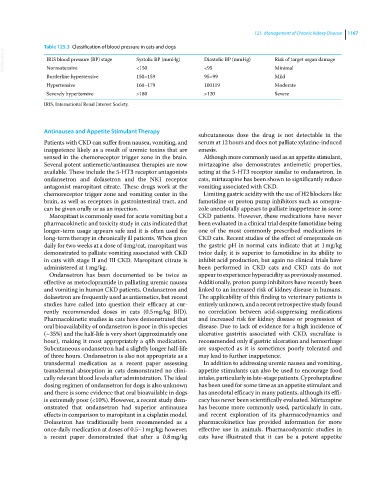Page 1229 - Clinical Small Animal Internal Medicine
P. 1229
125 Management of Chronic Kidney Disease 1167
Table 125.3 Classification of blood pressure in cats and dogs
VetBooks.ir IRIS blood pressure (BP) stage Systolic BP (mmHg) Diastolic BP (mmHg) Risk of target organ damage
Normotensive
<150
<95
Minimal
Borderline hypertensive 150–159 95–99 Mild
Hypertensive 160–179 100119 Moderate
Severely hypertensive >180 >120 Severe
IRIS, International Renal Interest Society.
Antinausea and Appetite Stimulant Therapy
subcutaneous dose the drug is not detectable in the
Patients with CKD can suffer from nausea, vomiting, and serum at 12 hours and does not palliate xylazine‐induced
inappetence likely as a result of uremic toxins that are emesis.
sensed in the chemoreceptor trigger zone in the brain. Although more commonly used as an appetite stimulant,
Several potent antiemetic/antinausea therapies are now mirtazapine also demonstrates antiemetic properties,
available. These include the 5‐HT3 receptor antagonists acting at the 5‐HT3 receptor similar to ondansetron. In
ondansetron and dolasetron and the NK1 receptor cats, mirtazapine has been shown to significantly reduce
antagonist maropitant citrate. These drugs work at the vomiting associated with CKD.
chemoreceptor trigger zone and vomiting center in the Limiting gastric acidity with the use of H2 blockers like
brain, as well as receptors in gastrointestinal tract, and famotidine or proton pump inhibitors such as omepra-
can be given orally or as an injection. zole anecdotally appears to palliate inappetence in some
Maropitant is commonly used for acute vomiting but a CKD patients. However, these medications have never
pharmacokinetic and toxicity study in cats indicated that been evaluated in a clinical trial despite famotidine being
longer‐term usage appears safe and it is often used for one of the most commonly prescribed medications in
long‐term therapy in chronically ill patients. When given CKD cats. Recent studies of the effect of omeprazole on
daily for two weeks at a dose of 4 mg/cat, maropitant was the gastric pH in normal cats indicate that at 1 mg/kg
demonstrated to palliate vomiting associated with CKD twice daily, it is superior to famotidine in its ability to
in cats with stage II and III CKD. Maropitant citrate is inhibit acid production, but again no clinical trials have
administered at 1 mg/kg. been performed in CKD cats and CKD cats do not
Ondansetron has been documented to be twice as appear to experience hyperacidity as previously assumed.
effective as metoclopramide in palliating uremic nausea Additionally, proton pump inhibitors have recently been
and vomiting in human CKD patients. Ondansetron and linked to an increased risk of kidney disease in humans.
dolasetron are frequently used as antiemetics, but recent The applicability of this finding to veterinary patients is
studies have called into question their efficacy at cur- entirely unknown, and a recent retrospective study found
rently recommended doses in cats (0.5 mg/kg BID). no correlation between acid‐suppressing medications
Pharmacokinetic studies in cats have demonstrated that and increased risk for kidney disease or progression of
oral bioavailability of ondansetron is poor in this species disease. Due to lack of evidence for a high incidence of
(~35%) and the half‐life is very short (approximately one ulcerative gastritis associated with CKD, sucralfate is
hour), making it most appropriately a q8h medication. recommended only if gastric ulceration and hemorrhage
Subcutaneous ondansetron had a slightly longer half‐life are suspected as it is sometimes poorly tolerated and
of three hours. Ondansetron is also not appropriate as a may lead to further inappetence.
transdermal medication as a recent paper assessing In addition to addressing uremic nausea and vomiting,
transdermal absorption in cats demonstrated no clini- appetite stimulants can also be used to encourage food
cally relevant blood levels after administration. The ideal intake, particularly in late‐stage patients. Cyproheptadine
dosing regimen of ondansetron for dogs is also unknown has been used for some time as an appetite stimulant and
and there is some evidence that oral bioavailable in dogs has anecdotal efficacy in many patients, although its effi-
is extremely poor (<10%). However, a recent study dem- cacy has never been scientifically evaluated. Mirtazapine
onstrated that ondansetron had superior antinausea has become more commonly used, particularly in cats,
effects in comparison to maropitant in a cisplatin model. and recent exploration of its pharmacodynamics and
Dolasetron has traditionally been recommended as a pharmacokinetics has provided information for more
once‐daily medication at doses of 0.5–1 mg/kg; however, effective use in animals. Pharmacodynamic studies in
a recent paper demonstrated that after a 0.8 mg/kg cats have illustrated that it can be a potent appetite

